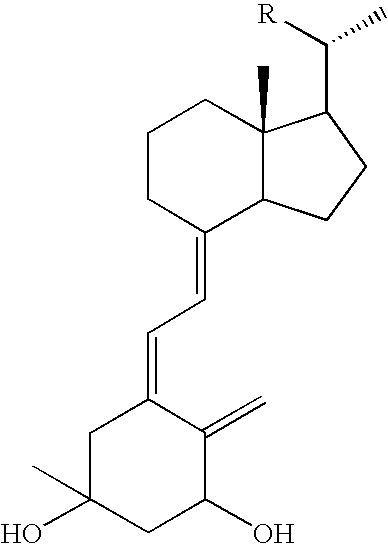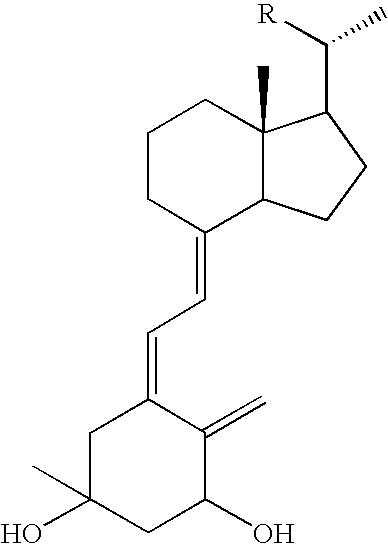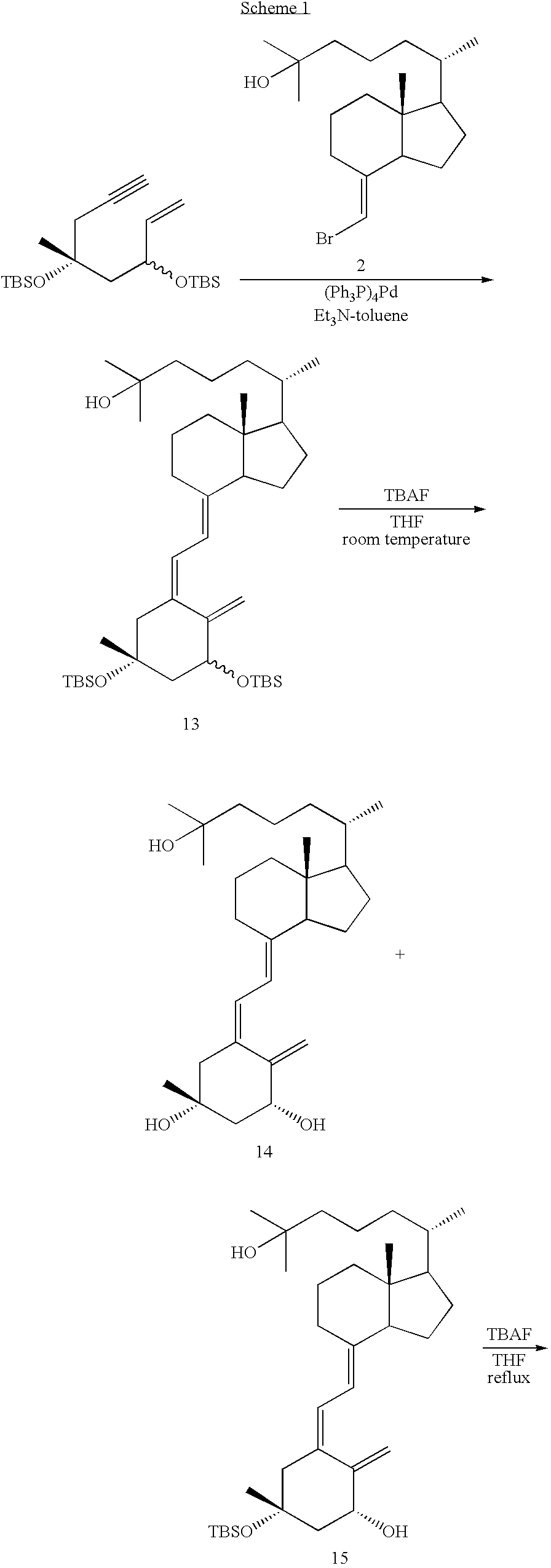3-Methyl-20-epi-vitamin D derivatives
- Summary
- Abstract
- Description
- Claims
- Application Information
AI Technical Summary
Benefits of technology
Problems solved by technology
Method used
Image
Examples
example 1
Synthesis of (5Z,7E)-(1R,3R,20S)-3-methyl-9,10-seco-5,7,10(19)-cholestatriene-1,3,25-triol (Compound 14)
[0028] (E)-de-A,B-8-(bromomethylene)cholestan-25-ol (Compound 2) (124 mg, 0.35 mmol) and triethylamine (5 ml) were mixed in toluene (3 ml); the resulting solution was mixed with (Ph3P)4Pd (121 mg, 0.11 mmol) and stirred at room temperature for 10 minutes. A solution of an A-ring compound (Compound 12) (64 mg, 0.18 mmol) in toluene (2 ml) was then added, followed by stirring at room temperature for a further 10 minutes. The A-ring Compound 12 was synthesized by the method described on page 105 of Abstracts of the 120th Annual Meeting of the Pharmaceutical Society of Japan 2 via a 3-methylbutane-1,2,4-triol derivative, which had been synthesized from 3-methylbut-3-en-1-ol, as a starting material. The reaction mixture was heated under reflux for 1.5 hours, mixed with brine and extracted with ethyl acetate. The thus obtained organic layer was dried over magnesium sulfate and filtered...
example 2
Synthesis of (5Z,7E)-(1S,3R,20S)-3-methyl-9,10-seco-5,7,10(19)-cholestatriene-1,3,25-triol (Compound 16)
[0031] Under an argon atmosphere at 60° C., a solution of Compound 15 (23 mg, 0.041 mmol) in THF (1 ml) was treated with TBAF (1.0 M solution in THF, 0.4 ml, 0.4 mmol) for 15 hours. After the treatment, brine was added to thus obtained mixture and extracted with ethyl acetate. The organic layer was dried over magnesium sulfate and filtered. The filtrate was evaporated for removing the solvent to give a crude product. This crude product was subjected to silica gel chromatography (ethyl acetate:n-hexane=2:1) to give Compound 16 (17 mg) as a white solid. The yield was 82%. Compound 16 was further purified by reverse phase recycle HPLC (YMC-Pack ODS column, 20 mm×150 mm, 9.0 ml / min, acetonitrile:water=8:2) for biological activity evaluation.
[0032] UV (EtOH) λmax 263 nm, λmin 228 nm; 1H NMR (400 MHz, CDCl3) δ 0.55 (3 H, s), 0.85 (3H, d, J=6.4 Hz), 1.21 (6 H, s), 1.32 (3 H, s), 1.51 (...
example 3
Synthesis of (5Z,7E)-(lS,3S,20S)-3-methyl-9,10-seco-5,7,10(19)-cholestatriene-1,3,25-triol (Compound 19)
[0033] (E)-de-A,B-8-(bromomethylene)cholestan-25-ol (Compound 2) (237 mg, 0.62 mmol) and triethylamine (5 ml) were dissolved in toluene (6 ml), to which (Ph3P)4Pd (104 mg, 0.09 mmol) was added and stirred at room temperature for 10 minutes. Then, a solution of Compound 17 (110 mg, 0.31 mmol) which was an A-ring part compound in toluene (2 ml) was added to the mixture, followed by stirring for a further 10 minutes at room temperature. Compound 17, an A-ring part, was synthesized by the method described in Abstracts of the 120th Annual Meeting of the Pharmaceutical Society of Japan 2 (p. 105) via a 3-methylbutane-1,2,4-triol derivative, which was synthesized from 3-methylbut-3-en-1-ol, as a starting material. The mixture was heated under reflux for 1.5 hours, mixed with brine and extracted with ethyl acetate. The organic layer was dried over magnesium sulfate and filtered. The filt...
PUM
 Login to view more
Login to view more Abstract
Description
Claims
Application Information
 Login to view more
Login to view more - R&D Engineer
- R&D Manager
- IP Professional
- Industry Leading Data Capabilities
- Powerful AI technology
- Patent DNA Extraction
Browse by: Latest US Patents, China's latest patents, Technical Efficacy Thesaurus, Application Domain, Technology Topic.
© 2024 PatSnap. All rights reserved.Legal|Privacy policy|Modern Slavery Act Transparency Statement|Sitemap



